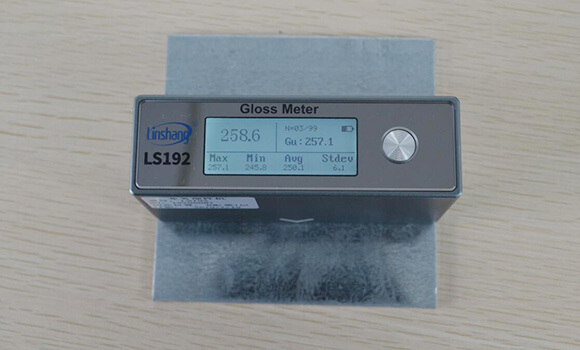Gloss Meter | Alloy Surface Glossiness Measurement
1.What is alloy gloss?
Alloys are solid products with metallic properties after being mixed and melted by several metals or non-metals after cooling and solidification. The surface usually has a high metallic luster. The alloy gloss here refers to the ability of the alloy surface to reflect visible light. The strength of the alloy gloss depends on the refractive index, absorption rate and reflectivity of the alloy surface. The greater the reflectivity, the stronger the alloy gloss. Such as aluminum alloy surface has a very strong metallic luster.
2. Which alloy has high gloss?
Due to the difference in alloy structure and manufacturing process, it will cause the alloy to show a big difference in gloss. For example, aluminum alloys, good aluminum alloys have bright cuts and good gloss, while poor aluminum alloys have dim cuts and no gloss. Even rust spots can be seen on the reverse side. Of course, sometimes the difference in alloy gloss is not so obvious. It is difficult to determine which alloy has higher gloss by the naked eye. This is why we can use a professional gloss meter to separately detect the gloss of different alloy surfaces and then analyze and compare the gloss. Higher alloy material.
3. Selection of alloy gloss meter
(1) What is a gloss meter and its measurement principle?
Gloss meter, as a gloss test instrument for surface glossiness of materials, applied to paint, decoration materials, construction materials, plastic materials, ceramic products, stone products, bamboo products, leather products, film paper, printing inks, etc. industry. Under the condition that the opening angle of the light source and the receiver is specified, the ratio of the reflected light flux of the sample in the specular reflection direction to the reflected light flux of the glass standard sample in the specular reflection direction. The polished black glass with a refractive index of 1.567 is set to a specular gloss value of 100 (gloss unit) at a geometric angle of 60 degrees.
(2) What functions should a good gloss meter have?
From the principle of the gloss meter, we can see that the gloss meter is a comparative test quantity that needs to be compared with the standard board. The standard board is easy to be affected by scratches and dust. In the design of the instrument, the standard board needs to be considered for good protection. The stability of the gloss meter light source and whether there is a temperature compensation function are also important factors for the stability of the instrument. We know that the luminous efficiency is different when the light source has different temperatures and different supply currents. Therefore, the light source of the general gloss meter needs a constant current source and a temperature compensation circuit to ensure the stability of the light source. Constant gloss sources can be achieved by general gloss meters, but there are differences in the accuracy of constant current sources. But for temperature compensation, only a few gloss meters have this function.
Linshang LS192 gloss meter can be used for surface gloss test of paints, coatings, inks, plastics, paper, ceramic tiles, ceramics, stone, metal and electroplated layers. It also has temperature compensation function, the glossiness measurement range can reach 1000GU, test The data can be comparable to the German BYK gloss meter. Therefore, to measure the gloss of the alloy, you can use the Linshang glossmeter.
